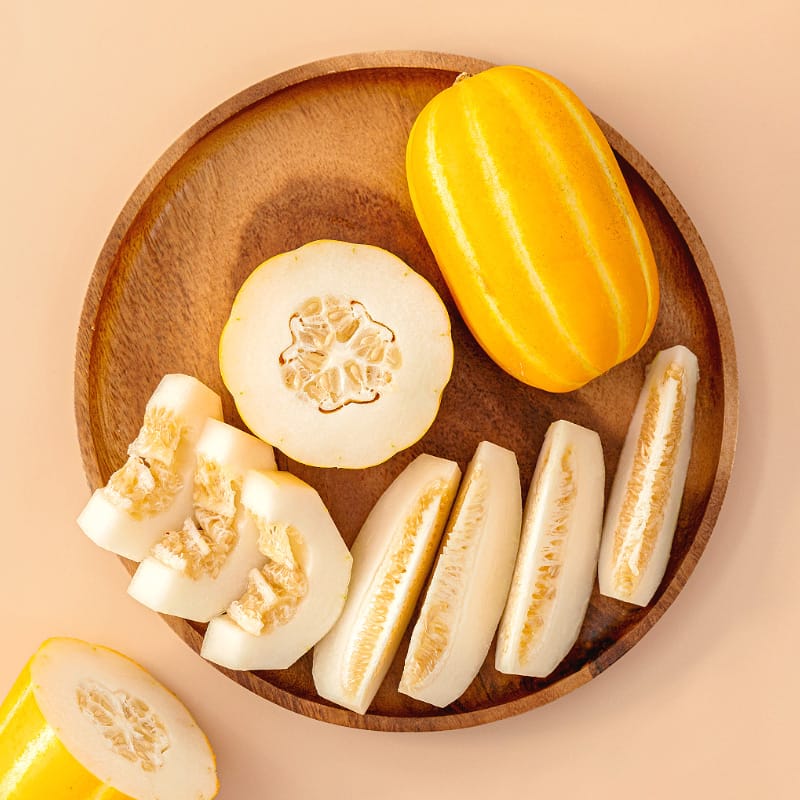K-Melon Rises: How Korea’s Chamoe Is Poised for Global Fruit Fame
South Korea’s chamoe, once a domestic summer staple, is now winning over global consumers thanks to export breakthroughs and high-tech farming.

In a quiet rural town in South Korea’s North Gyeongsang Province, rows of small yellow melons glide along a conveyor belt under the scrutiny of an artificial intelligence scanner. Each fruit—golden, oval, and marked with white stripes—is photographed, analyzed for sweetness, moisture, and surface flaws, then carefully packed for overseas shipment. These melons, known locally as chamoe, are no longer just a seasonal delicacy; they are fast becoming one of South Korea’s most promising fresh produce exports.
On May 7, Minister of Agriculture, Food and Rural Affairs Song visited the Woehang Agricultural Cooperative’s export grading center in Seongju County to review the chamoe export process and encourage local producers. Her visit came just weeks after a milestone: the first official shipment of Korean chamoe to Vietnam in March, following a successful phytosanitary agreement that took 17 years to finalize. Over 33 metric tons of Seongju-grown chamoe have since entered the Vietnamese market, with supply agreements signed with major retailers and even national airlines for in-flight meals.
The Ministry’s support reflects a broader strategy to expand the global reach of Korean agriculture in the face of uncertain trade conditions and increasing climate volatility. Chamoe—once known almost exclusively within Korea—is now being positioned alongside strawberries and Shine Muscat grapes as part of the “K-Fruit” portfolio. With its crisp texture, mild sweetness, and cultural cachet, the fruit is now gaining traction in markets like Japan, Singapore, Australia, and Vietnam.
But despite its growing appeal, chamoe remains a rarity abroad. Why has this fruit flourished almost exclusively in Korea? And how is it overcoming climatic, cultural, and logistical barriers to emerge as a new face of Korean soft power?
Origins and Cultural Localization
Although now firmly embedded in Korean agriculture and cuisine, chamoe’s botanical ancestry stretches far beyond the peninsula. As a cultivar of Cucumis melo, its lineage can be traced to Central Asia or northern India, where early melons were first domesticated millennia ago. The fruit likely reached East Asia through ancient overland trade routes, including the Silk Road, evolving along the way as it adapted to new climates and consumer tastes.
By the 6th and 7th centuries, yellow melon varieties resembling chamoe had been documented in Chinese agrarian texts such as the Qimin Yaoshu, which detailed early cultivation practices. From there, these melons are believed to have entered Korea during the Unified Silla or Goryeo periods, likely through cultural and agricultural exchange with Tang China.
Yet it was on Korean soil that chamoe became something singular. By the Joseon Dynasty, the fruit had been fully assimilated into Korean seasonal traditions, with references appearing in farming manuals like the Nongga Jipseong. It was offered as part of royal tribute, consumed during summer ancestral rites, and embraced for its simplicity in Buddhist temple cuisine.
The name itself reflects cultural appropriation and elevation: chamoe combines the Korean word cham (참), meaning “genuine” or “authentic,” with oe (외), meaning “melon.” This nomenclature suggests more than just taxonomy—it signals a national fruit, shaped as much by the Korean climate and palate as by centuries of local selection.
Unlike the large, juicy melons favored in Western markets, chamoe developed with Korean sensibilities in mind: compact in size, bright yellow with clean white stripes, crisp in texture, and subtly sweet. It’s eaten after a quick peel, often enjoyed as a refreshing snack in humid summers or served with rice dishes in traditional settings.
Over time, chamoe has evolved from a foreign introduction into a deeply Korean creation—rooted not only in the soil, but in culinary memory, cultural ritual, and regional pride.
Why Chamoe Is Uniquely Korean
Chamoe’s deep cultural roots in Korea are matched by a unique convergence of agricultural conditions that have made it nearly impossible to replicate elsewhere. Despite its adaptability as a melon cultivar, chamoe remains—by both geography and identity—a fruit that thrives almost exclusively within South Korean borders.
Climatic suitability is a fundamental reason. Chamoe prefers dry, warm conditions with ample sunlight and stable day-night temperature variation. These conditions are naturally found in parts of the Korean Peninsula, particularly in North Gyeongsang Province, where the town of Seongju now produces up to 80 percent of the nation’s total yield. While many fruits can be cultivated in diverse climates, chamoe’s shallow roots and moisture sensitivity make it especially vulnerable to excessive rain or humidity—conditions common in other parts of Asia and much of the Western world.
Korean agricultural infrastructure has also evolved to meet the crop’s particular needs. Farmers in Seongju and neighboring regions have long utilized plastic-covered greenhouses and rainproof growing systems that allow for precise control of temperature and irrigation. In recent years, technological integration has accelerated: AI-based sorting machines now assess sugar content and surface defects, while CA (Controlled Atmosphere) logistics enable longer-distance exports without compromising freshness. These innovations are not merely conveniences—they are prerequisites for chamoe’s commercial viability.
Yet the fruit’s Korean exclusivity is not just a matter of soil and structure. It is a function of demand. Korean consumers have a strong preference for compact, individually portioned fruits with clean sweetness and crisp texture—traits that align perfectly with chamoe’s natural profile. It is not uncommon to find chamoe served alongside rice dishes, included in school lunches, or arranged on ceremonial altars. Its cultural resonance reinforces its place in the national diet, unlike in Western markets, where larger, juicier melons dominate.
Moreover, chamoe’s short shelf life poses a structural challenge to global expansion. The fruit begins to degrade within days of harvest, making traditional maritime shipping routes impractical without advanced preservation methods. Until recently, this fragility confined chamoe to domestic markets and nearby neighbors such as Japan.
All of this makes chamoe not merely a Korean crop, but a Korean system—a fruit that relies on specific climate, high-tech infrastructure, culinary tradition, and consumer alignment to thrive. Its story is one of agricultural specialization, not generalization—part of why its international journey is so noteworthy.
Global Export Expansion
Although historically confined to domestic markets, Korean chamoe has begun expanding into international markets following a series of phytosanitary breakthroughs and logistical innovations. The most notable development occurred in 2023, when South Korea and Vietnam finalized a bilateral plant quarantine agreement that had been under negotiation since 2008. This enabled the first official shipment of Korean chamoe to Vietnam in March 2024—17 years after talks began.
According to the Ministry of Agriculture, Food and Rural Affairs (MAFRA), a total of 33 metric tons of Seongju-grown chamoe were exported to Vietnam in the initial months of the agreement. These exports were supplied through partnerships with large local retailers, including Lotte Mart Vietnam, and through supply contracts with Vietnamese airline catering services. As of April 2024, chamoe accounted for 20 percent of total melon category sales in Lotte Mart stores in Vietnam.
Japan has been the most consistent importer of Korean chamoe to date. Korean exporters have maintained trade routes with Japan for over a decade, supplying the fruit to major retail chains such as Costco and AEON. In 2023, Japan remained one of the top destinations for Korean chamoe exports in both volume and revenue.
Additional markets include Singapore, Hong Kong, and Australia, where Korean chamoe is positioned as a premium fruit targeting Korean expatriates and high-income consumers familiar with K-Food products. Most exports are handled via air freight due to chamoe’s short shelf life. However, in 2024, Korean exporters began utilizing CA (Controlled Atmosphere) maritime containers, which lower oxygen and increase CO₂ levels during shipment to slow fruit respiration and extend freshness. This method reportedly reduced spoilage rates from approximately 40 percent to under 5 percent.
The export push is backed by government policy. In March 2024, MAFRA selected chamoe as part of its 2025 priority list for phytosanitary negotiation and export expansion, alongside six agricultural and five livestock products. This initiative is part of a broader strategy to diversify Korea’s agricultural export portfolio in the face of growing global trade uncertainty.
Despite these gains, Korean chamoe remains a niche product in global markets due to low name recognition and logistical challenges. Still, early signs suggest increasing awareness and demand, particularly in regions where Korean cultural influence is strong.
Climate Challenges and Technological Innovation
As global climate volatility increases, Korean chamoe producers are facing mounting challenges related to crop consistency, disease management, and post-harvest quality retention. The fruit’s sensitivity to environmental fluctuations—particularly excessive rainfall and extreme temperatures—makes it especially vulnerable to climate-related disruption.
According to data from the Korea Meteorological Administration, the number of days with temperatures exceeding 33°C has risen significantly over the past decade, particularly during the chamoe growing season from April to July. Prolonged heat stress can inhibit fruit development and increase the incidence of surface cracking, while erratic rain patterns raise the risk of fungal infections such as anthracnose and bacterial soft rot.
In response, Korean growers have adopted a variety of technological and structural solutions. Most chamoe production now takes place under semi-controlled greenhouse conditions using rainproof plastic tunnels, which mitigate the effects of external weather conditions. These structures help regulate soil moisture and reduce the risk of root diseases caused by waterlogging.
At the post-harvest stage, artificial intelligence is increasingly used to maintain quality standards. In facilities like the Woehang Agricultural Cooperative in Seongju, AI-powered grading machines capture up to 18 images of each melon and analyze parameters such as sugar content, water retention, skin blemishes, and uniformity. This allows exporters to meet strict quality requirements demanded by overseas buyers, particularly in premium markets.
One of the most significant logistical advancements is the introduction of Controlled Atmosphere (CA) shipping containers, which adjust the internal composition of air—reducing oxygen levels and increasing carbon dioxide—to slow down fruit respiration during transit. According to the Woehang Cooperative, this technology has reduced spoilage rates from approximately 40 percent to as low as 5 percent during sea transport, enabling chamoe to be exported via lower-cost maritime routes for the first time.
These innovations are increasingly seen as essential, not optional. In a May 2024 site visit to Seongju, Agriculture Minister Song Mi-ryeong emphasized the importance of strict quality management "from field to export," citing extreme weather as a persistent risk. She called for tighter coordination between producers, exporters, and inspection agencies to maintain consistency and competitiveness in overseas markets.
As climate risks escalate, the success of Korean chamoe may depend as much on technology and adaptation as on cultivation—a shift that reflects broader trends across the global fresh produce industry.
Strategic Future for Chamoe as a K-Fruit Export
As global demand for culturally distinct and high-quality produce grows, Korean chamoe is well-positioned to follow in the footsteps of other successful K-Fruits such as Shine Muscat grapes and premium strawberries. However, its future as an internationally recognized export crop will depend on a combination of strategic branding, market diversification, and continued investment in logistics and cultivation technology.
According to South Korea’s Ministry of Agriculture, Food and Rural Affairs (MAFRA), chamoe has been included in the list of priority export commodities for 2025 under the government’s phytosanitary negotiation roadmap. This designation means that additional diplomatic and regulatory efforts will be made to open new markets and streamline export certification processes.
One key pillar of chamoe’s export potential lies in branding and differentiation. Unlike common Western melons, Korean chamoe offers a unique value proposition: it is smaller, easier to handle, and has a crisp, refreshing texture that aligns with current health-conscious consumer trends. There is growing interest in positioning chamoe as a “K-Melon,” mirroring the success of the “K-Food” and “K-Beauty” campaigns that have accompanied the global spread of Korean culture.
Retail packaging is also being adapted for international audiences, with bilingual labeling, traceability QR codes, and visual identifiers that emphasize its Korean origin. For example, in Vietnam, export-grade chamoe is sold with Korean-language branding and often promoted during holidays as a premium gift item—a cultural parallel to how Shine Muscat grapes are marketed in Japan.
At the same time, market development remains cautious but promising. Beyond Vietnam and Japan, exploratory shipments have been made to Singapore, Australia, and Hong Kong. These regions, which already have a high degree of exposure to Korean food products, are viewed as stepping stones toward broader market access in Europe and North America. However, the perishability of chamoe and its limited global name recognition remain persistent barriers.
To overcome these challenges, industry experts recommend continued expansion of CA maritime logistics and exploration of shelf-stable secondary products, such as chamoe juice, dried chamoe snacks, or processed skincare ingredients using chamoe extract—following a path similar to Korean pears and ginseng.
More fundamentally, the long-term viability of chamoe exports will depend on strengthening the entire value chain—from seed development and climate-resilient farming, to automated grading and targeted overseas marketing. Public-private partnerships and rural innovation funding are likely to play a central role in this evolution.
As of mid-2025, Korean chamoe is still a niche export product, but with rising investment, government support, and growing interest in culturally specific produce, it has the potential to become a flagship example of Korea’s soft power in agriculture.



Comments ()